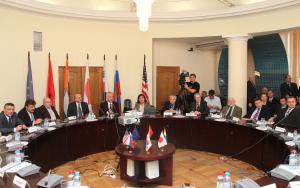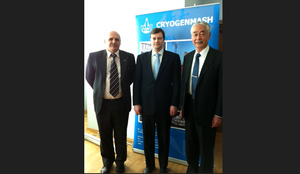On mission to Moscow
15 Mar 2012
-
Sabina Griffith
Approximately 20 journalists and high-ranking representatives from Russian industry gathered around the conference table at the Kurchatov Institute this week for the signature ceremony for ITER's neutral particle analyzer.
On 6 and 7 March ITER Director-General Osamu Motojima visited Moscow, a mission intended to inform the representatives of the Russian party first-hand about the status of the ITER Project and to hear in exchange about progress in procurement and manufacturing in Russia. During this visit, the Procurement Arrangement for ITER's neutral particle analyzer (see textbox below) and the Arrangement on the operation of the SULTAN test facility and sample manufacture were signed.
At the Domestic Agency (RF-DA) located on the premises of the Kurchatov Institute, the Director-General first met the Russian delegates to the ITER Council, delegation leader Igor Borovkov, former Council Chair Evgeny Velikhov; Contact Person Vladimir Vlasenkov, recently appointed ROSATOM Deputy Director-General Vyacheslav Persukov and the head of the Russian Domestic Agency, Anatoli Krasilnikov. Director Motojima briefly explained the status of the project including the current project schedule performance and the Members' budget situation.
In a second session with Anatoli Krasilnikov and ROSATOM representative Viacheslav Pershukov, technical issues concerning the ITER divertor were discussed as well as the recent visit of seven young Russian researchers to ITER Headquarters, a well-received initiative supported by ROSATOM.
Approximately 20 journalists and high-ranking representatives from the Russian industry then gathered around the conference table at the RF-DA. This was the first time for them to be assembled all together. Academician Velikhov, one of the spiritual fathers of the ITER project, gave a short recap of the history of nuclear fusion research and ITER, highlighting the significant role of the Russian Federation. Director-General Motojima presented the project status in detail and fielded many questions from the journalists present.
Click here to listen to the interview with the Moscow radio station "Echo of Moscow" (in Russian).
Click here to watch to the interview with Director-General Motojima on the Russian TV-channel "Russia-24" (in Russian).
Click here to watch a 14-minute report on ITER on "Russia-24" (in Russian).
A meeting with Domestic Agency staff was also held with a view to enhancing the mutual understanding between the ITER Organization and the RF-DA.
A meeting with Domestic Agency staff was also held with a view to enhancing the mutual understanding between the ITER Organization and the RF-DA.
RF-DA Head Anatoli Krasilnikov (left) and ITER Director-General Osamu Motojima with the CEO of Cryogenmash, Mikhail Smirnov.
The following day a visit was organized to JSC Cryogenmash, a cryogenic engineering company located in Balashikha near Moscow. The company's origins date back to the engineering plant created by Nobel Prize winner Pyotr Leonidovich Kapitsa in 1945. Cryogenmash has a long experience in building cryogenic systems for large research facilities and is responsible for the design and construction of ITER's port plug test facility stands.



